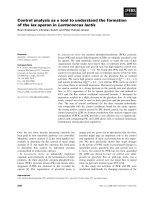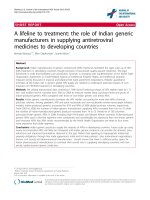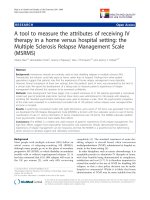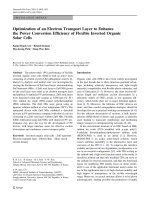Design of a promoter to enhance the stability of catalysts for hydrocarbon reactions 1
Bạn đang xem bản rút gọn của tài liệu. Xem và tải ngay bản đầy đủ của tài liệu tại đây (208.19 KB, 18 trang )
ACKNOWLEDGEMENTS
Firstly, I would like to express my sincere appreciation to my supervisor, Dr. Mark
Saeys, for his encouragement, insight, support and guidance throughout the course of
this research project. He has been an invaluable help by providing technical guidance
and support pertaining to my research work.
I also wish to extend my sincere gratitude to Dr. Armando Borgna from ICES for his
supervision during my experimental studies in ICES. I am also thankful to Dr. Chen
Luwei and other colleagues in ICES for their helpful discussions on my experimental
studies.
I would sincerely like to thank my group members such as Sun Wenjie, Tan Kong Fei,
Hong Won Keon, Chua Yong Ping Gavin, Fan Xuexiang, Zhuo Mingkun, Su Mingjuan,
Ravi Kumar Tiwari, Shangguan Wangzuo and Dianna Otalvaro for their help, support
and encouragement throughout my research work.
Finally, special thanks to my dear husband Ye Ming, for being there to support me as I
pursue my doctorate degree. I am extremely grateful for his love, patience and
especially his understanding, which have enabled my doctorate journey to be
meaningful and successful.
I
TABLE OF CONTENTS
Acknowledgements···········································································································I
Table of contents············································································································· II
Summary ·······················································································································VI
Symbols and abbreviations ························································································· VIII
List of tables ··················································································································XI
List of figures·············································································································· XIII
Publications ············································································································· XVIII
Chapter 1 Introduction····································································································· 1
Chapter 2 First Principles Based Design of Metal Catalysts ············································5
2.1
Introduction ·········································································································· 5
2.2 Models of Catalytic Surface ················································································· 6
2.3 Hydrogenation of Olefins and Aromatics ····························································· 8
2.4 Ammonia Synthesis···························································································· 15
2.5 Steam Reforming ······························································································· 19
2.6 Selective Catalytic Oxidation ············································································· 21
2.7 References ········································································································· 24
Chapter 3 Computational Methods ··············································································· 27
3.1 Quantum Chemistry: Theory and Methods ························································ 27
3.1.1 Fundamentals······························································································ 27
3.1.2 Density Functional Theory (DFT) ······························································ 28
3.1.3 Exchange-Correlation Functional ······························································· 30
3.1.4 Plane-Wave Basis Sets ··············································································· 32
II
3.1.5 Pseudopotentials ························································································ 32
3.1.6 The Vienna Ab Initio Simulation Package·················································· 33
3.1.7 Nudged Elastic Band Method (NEB)·························································· 36
3.2 Computational Methodology ············································································· 38
3.3
References ········································································································· 39
Chapter 4 First Principles Based Design of Ni Catalysts with Improved Coking
Resistance ···································································································· 41
4.1 Introduction ······································································································· 41
4.2
Computational Methods ···················································································· 48
4.3 Thermodynamic Diagram for Chemisorbed Carbon on Ni Catalyst ·················· 50
4.3.1 Chemisorption of On-surface Carbon on Ni(111)······································· 50
4.3.2 Chemisorption of Subsurface Carbon on Ni(111)······································· 51
4.3.3 Stability of Bulk Carbon in Ni Catalyst ······················································ 55
4.3.4 Distribution of Carbon Atoms between On-surface and Subsurface Sites ·· 56
4.3.5 Stability of Graphene Overlayer on Ni(111)··············································· 61
4.3.6 Chemisorption of Carbon at the Ni(211) steps············································ 63
4.4 Kinetics of Formation of Subsurface and Bulk Carbon, and of Graphene Islands
on a Ni Catalyst·································································································· 65
4.4.1 Effect of the Unit Cell Size on the Diffusion Barrier of On-surface Carbon
Atoms to the First Subsurface Layer··························································· 66
4.4.2 Effect of Coverage/Concentration on Kinetics of Carbon Diffusion··········· 67
4.4.3 Kinetics of the Formation of Graphene Islands from On-surface Carbon
Atoms ········································································································ 77
4.5 Effect of Boron on the Stability of Carbon on a Ni Catalyst ······························ 83
4.5.1 Thermodynamic Diagram for Boron Chemisorption on Ni(111) ················ 83
4.5.2 Chemisorbed Boron at the Ni(211) Steps···················································· 88
4.6 Summary ······································································································· 90
4.7 References·········································································································· 92
III
Chapter 5 First Principles Study of the Effect of Carbon and Boron on the Activity
of a Ni Catalyst ····························································································· 95
5.1 Introduction ······································································································· 95
5.2 Computational Methods ···················································································· 99
5.3 Effect of Subsurface Carbon and Boron on Methane Activation ····················· 102
5.3.1 Stability of subsurface carbon and boron·················································· 102
5.3.2 Clean Ni(111) Surface·············································································· 106
5.3.3 Ni(111) with Subsurface Carbon······························································ 108
5.3.4 Ni(111) with Subsurface Boron································································ 114
5.4 Effect of Carbon and Boron on Methane Activation at Step Sites ··················· 115
5.4.1 Clean Ni(211) Surface·············································································· 116
5.4.2 Ni(211) Surface with Step Sites Blocked by Carbon································ 117
5.4.3 Ni(211) Surface with Step Sites Blocked by Boron·································· 120
5.5 Summary ········································································································· 123
5.6 References······································································································· 125
Chapter 6 Effect of Boron on the Stability of Ni Catalysts during Steam Methane
Reforming ··································································································· 127
6.1 Introduction······································································································ 127
6.2
Catalyst Synthesis····························································································· 129
6.3 Catalyst Characterization ·················································································· 129
6.4 Catalyst Testing ································································································ 132
6.5 Results and Discussion······················································································ 133
6.5.1 Catalyst Characterization ·········································································· 133
6.5.2 Methane Steam Reforming········································································ 139
6.5 Summary ·········································································································· 147
6.5 References········································································································· 148
IV
Chapter 7 Conclusions and Future Suggestions ··························································· 151
V
SUMMARY
Deactivation by carbon deposition is a common challenge in many catalytic processes
involving hydrocarbons, such as steam reforming of methane and heavier hydrocarbons
over Ni-based catalysts. First principles Density Functional Theory (DFT) calculations
were combined with experimental investigations to design Ni catalysts with improved
stability.
To develop a molecular level understanding of the coking mechanism on Ni catalysts,
the stability of different forms of carbon that can exist on Ni catalyst and the kinetics of
carbon diffusion were studied using first principles calculations. Extended graphene
islands were found to be the most stable form of carbon on a Ni catalyst, with a carbon
binding energy of –760 kJ/mol. However, the formation of graphene islands resembles a
nucleation process and requires critical islands of about 15-20 carbon atoms. Step sites
are the preferred adsorption sites for carbon atoms and can act as nucleation sites for the
formation of graphene islands. On-surface carbon atoms are relatively unstable with
binding energies of around –660 kJ/mol. Subsurface octahedral sites are also more
stable than on-surface sites, and subsurface carbon is expected to build up easily under
typical steam reforming reaction conditions. The presence of subsurface carbon
significantly decreases the activity of Ni catalysts and the methane activation energy
increases from 101 kJ/mol to 143 kJ/mol, when all the sites in the first subsurface layer
are occupied by carbon atoms.
VI
Calculations indicate that boron atoms preferentially bind at the step sites and at
octahedral sites just below the surface. Boron and carbon atoms hence show similar a
relative binding preference, and boron is proposed to selectively block both step and
subsurface sites. In addition, subsurface boron atoms were found to restructure the
Ni(111) surface and lower the methane dissociation barrier from 101 kJ/mol to 64
kJ/mol. Hence, boron atoms are believed to enhance the catalyst stability and do not
reduce the catalyst activity.
In order to validate our DFT predictions, Ni catalysts promoted with 0.5 wt% and 1.0
wt% boron were synthesized, characterized and tested during steam methane reforming.
Experiments at 800 ºC and at a Gas Hourly Space Velocity (GHSV) of 330,000
cm
3
/hr·g
cat
demonstrate that promotion with 1.0 wt% boron not only reduces the
activity loss from 21% to 6%, but also enhances the initial conversion from 56% to
61%. At a higher GHSV of 660,000 cm
3
/hr·g
cat
, 1.0 wt% boron reduces the activity loss
from 70% to 30%. A Temperature Programmed Oxidation and Scanning Electron
Microscopy study of the catalysts confirmed that boron assists in preventing carbon
buildup. The theoretical predictions were experimentally validated, showing that boron
promotion enhances the catalysts stability during steam reforming.
VII
SYMBOLS AND ABBREVIATIONS
Symbols
),( Rx
ψ
Wave function
)(r
ρ
Electronic density
xc
ε
Exchange-correlation energy per particle of the uniform electron gas
E
Total energy of the system
b
E
Binding energy
edge
E
Edge energy
ee
E
Electron-electron repulsion energy
E
graphene
Total energy per carbon atom for the graphene-covered surface
)]([
0
rE
ncl
ρ
Non-classical contribution in electron-electron repulsion energy
ne
E
Nucleus-electron interaction energy
)]([
00
rE
ρ
Ground state energy
)]([ rE
XC
ρ
Exchange-correlation functional
)]([
0
rJ
ρ
Coulomb integral in electron-electron repulsion energy
i
R
Intermediate states in NEB
1
S
Spin
)]([ rT
ρ
Kinetic energy functional
),( RxV
Potential energy
)(rV
ext
External potential
VIII
Abbreviations
CPO Catalytic partial oxidation
DFT Density functional theory
FFT Fast fourier transformations
FLAPW Full-potential linearised augmented plane-wave-method
GGA Generalized gradient approximation
HREELS High-resolution electron energy loss spectroscopy
ICP-OES Inductively coupled plasma-optical emission spectrometry
LDA Local density approximation
MC Monte carlo
MEP Minimum energy path
NEB Nudged elastic band
PDOS Projected density of states
PES Potential energy surface
PAW Projector-augmented-wave
PES Potential energy surface
PW91 Perdew-Wang 91
RPBE Revised Perdew-Burke-Ernzerhof
RMM Residual minimization method
SEM Scanning electron microscopy
SHSV Gas hourly space velocity
SPARG Sulfur passivated reforming
TCD Thermal Conductivity Detector
SR Steam reforming
TPD Temperature Programmed Desorption
TOF Turnover frequency
TPO Temperature programmed oxidation
UHV
Ultra high vacuum
VASP Vienna ab initio simulation package
XRD X-Ray diffraction
IX
XPS X-ray photoelectron spectroscopy
X
LIST OF TABLES
Table 4.1. Carbon binding energies for the on-surface hcp hollow sites,
the octahedral sites for the first and second subsurface layer
and for octahedral sites in the Ni bulk
54
Table 4.2
Influence of the unit cell size on the activation energy and
reaction energy for carbon atom diffusion from the on-surface
fcc hollow site to the octahedral site below.
67
Table 4.3 Carbon diffusion barriers (kJ/mol) as a function of the carbon
concentrations in the first and the second subsurface layer.
75
Table 4.4.
Boron binding energies for the on-surface hcp hollow sites, the
octahedral sites for the first and second subsurface layer and
for octahedral sites in the Ni bulk.
87
Table 4.5
Boron binding energies for different configurations of four
boron atoms in a p(2x2) unit cell.
87
Table 5.1 Structure and binding energy for different surface structures
with subsurface carbon and boron.
105
Table 5.2
Methyl and hydrogen binding energies (kJ/mol) for the clean
Ni(111) surface, the Ni(111)-C
SS
surface with subsurface
carbon, and the Ni(111)-B
SS
surface with subsurface boron.
110
Table 5.3
Transition state geometries and barriers for methane activation
on Ni(111), Ni(111)-C
SS
and Ni(111)-B
SS
surfaces.
113
Table 5.4
Methyl and hydrogen binding energies (kJ/mol) for the
Ni(211) surface, the Ni(211) surface with all step sites
occupied by carbon, Ni(211)-C
step,100%
, by boron, Ni(211)-
B
step,100%
, and with half of the step sites occupied by boron,
Ni(211)-B
step,50%
.
119
Table 5.5 Transition state geometries and barriers for methane activation
on Ni(211), Ni(211)-C
step,100%
, Ni(211)-B
step,50%
and Ni(211)-
B
step,100%
surfaces.
121
Table 6.1
Bulk composition (ICP-OES), surface composition (XPS),
particle size (XRD) and dispersion for calcined 15 wt % Ni/γ-
137
XI
Al
2
O
3
catalysts promoted with boron.
XII
LIST OF FIGURES
Figure 2.1 Three approaches and examples for modeling
chemisorption and reactivity on surfaces. (Left) cluster
approach, maleic anhydride on Pd; (center) embedding
scheme: ammonia adsorption in a zeolite cage; (right)
periodic slab model: maleic anhydride adsorption on Pd(111).
7
Figure 2.2 Representative kinetic Monte Carlo simulation snapshot for
ethene hydrogenation over Pd.
13
Figure 2.3
Overview of the different reaction paths for benzene
hydrogenation. The dominant reaction path is indicated in
boldface. The hydrogenation activation energies for every
step along the dominant reaction path are indicated. The
energy values are given in kJ/mol.
13
Figure 2.4 Calculated turnover frequencies for ammonia synthesis as a
function of the adsorption energy of nitrogen for various
transition metals and alloys.
16
Figure 2.5 The calculaterd potential energy diagram for NH
3
synthesis
from N
2
and H
2
over Ru(0001) (dashed curve) and stepped
Ru(0001) (solid curve).
16
Figure 2.6
Energies for the species on Ni(211) and Ni(111). All
energies are relative to CH
4
and H
2
O in the gas phase and
calculated using the results for the individual species.
20
Figure 2.7
Conversion of n-butane as a function of time during steam
reforming in a 3% n-butane-7% hydrogen-3% water in helium
mixture at a space velocity of 1.2h
-1
. The dashed curve shows
the n-butane conversion for the Ni and the solid curve is for
the Au/Ni supported catalyst.
20
Figure 3.1
Typical flow-chart of VASP for the self consistent
determination of the Kohn-Sham ground state.
35
XIII
Figure 3.2 Schematic illustration of the nudged elastic band method.
Starting from an initially guessed reaction path (dashed line)
the chain converges to the nearest minimum path on the PES
(full line).
37
Figure 4.1
Carbon binding energies for chemisorption at the four high
symmetry sites of the Ni(111) surface as a function of
coverage. The symbols indicate the calculated binding
energies.
51
Figure 4.2
Binding energies for the on-surface hcp hollow sites (∆)
and the octahedral sites of the first (□) and second (x)
subsurface layer of the Ni(111) surface as a function of the
coverage and the concentration. The symbols indicate
calculated binding energies
54
Figure 4.3 Binding energies per carbon atom for selected
configurations of four carbon atoms distributed over the on-
surface and subsurface sites of a p(2x2) unit cell as a function
of the carbon concentration in the first subsurface layer. The
distribution between the first and second subsurface layer (●),
between the on-surface fcc and the first subsurface layer (■)
and between the on-surface hcp and the first subsurface layer
(▲) are presented.
58
Figure 4.4
Energy diagram for different distributions of four carbon
atoms over the on-surface hollow and the subsurface
octahedral sites of a p(2x2) unit cell. Starting from four on-
surface carbon atoms, the system lowers its total energy by
filling subsurface octahedral sites. Solid lines indicate the
thermodynamically preferred pathways.
59
Figure 4.5
Possible high symmetry adsorption modes for a graphene
overlayer on a Ni(111) surface. Carbon atoms are located at
(A) both the fcc and hcp threefold hollow sites; (B) atop and
fcc threefold hollow sites; (C) atop and hcp threefold hollow
sites; (D) two near atop sites.
62
XIV
Figure 4.6 The geometry of carbon at fivefold coordinated site on
Ni(211) surface. Carbon atoms are represented by smaller
balls and Ni atoms are represented larger balls Left panel,
50% carbon step coverage and right panel, 100% carbon step
coverage.
64
Figure 4.7
Calculation procedure for carbon diffusion barriers as a
function of on-surface coverage and of subsurface carbon
concentration.
70
Figure 4.8
Carbon diffusion barriers as a function of carbon
concentration in the first subsurface layer for low (1/9 ML,
∆), average (4/9 ML, ●) and high (1.0 ML, ◇ ) surface
coverages.
71
Figure 4.9 Diffusion barrier as a function of surface coverage for a
subsurface carbon concentration of 0%.
73
Figure 4.10 Relationship between diffusion barriers and reaction
energies for carbon diffusion from on-surface fcc sites to
octahedral sites in the first subsurface layer.
73
Figure 4.11
Model graphene structures used to determine the energy
cost for creating small size graphene islands: (A) a single line
structure; (B) a double line structure. The white circle indicate
unsaturated carbon atoms of the graphene structure, termed
edge atoms.
78
Figure 4.12
Model used to calculate the stability of small graphene
islands on the Ni(111) surface. Black and grey circles indicate
saturated, internal graphene atoms with a carbon binding
energy of –760 kJ/mol, white circles indicate unsaturated
edge atoms with a carbon binding energy of –635 kJ/mol.
79
Figure 4.13
The total energy of cluster as a function of the number of
atoms in the cluster.
79
XV
Figure 4.14 Proposed mechanism for carbon deposition on Ni-based
catalysts. On-surface carbon atoms, C*, are formed by
extensive dehydrogenation of hydrocarbon molecules, C
m
H
n
,
or by CO disproportionation. The on-surface carbon atoms
can (i) react with adsorb oxygen and hydrogen to form
products, (ii) diffuse to the Ni bulk, or (iii) combine to form
graphene islands.
82
Figure 4.15
Boron binding energies for chemisorption at the four high
symmetry sites of the Ni(111) surface and at the octahedral
sites of the first subsurface layer as a function of coverage.
85
Figure 4.16
Ni(111) surface with subsurface boron atoms after surface
reconstruction (top (a) and side (b) view). There are two
distinct top sites (T1 and T2) for the surface with subsurface
boron.
85
Figure 4.17
Reconstruction for 100% boron coverage at the steps. 89
Figure 5.1
Top view of methyl adsorbed at (a) fcc-t site and (b) fcc-b
sites on Ni(111) surface.
107
Figure 5.2
Ni(111) surface with subsurface carbon (top (a) and side (b)
view) and with subsurface boron atoms after surface
reconstruction (top (c) and side (d) view). The high symmetry
adsorption sites are indicated in (e). There are two distinct top
sites (T1 and T2) for the surface with subsurface boron.
109
Figure 5.3
Orbital scheme for C-H bond activation on transition metal
surfaces.
112
Figure 5.4
Correlation between the methane activation barrier and the
centre of the d-band projected on the surface Ni atoms
relative to the Fermi level for the different surfaces
considered.
112
XVI
Figure 5.5
Adsorption sites on a stepped Ni(211) surface (a and b).
Different step bridge site can be distinguished for 50%
coverage of the steps (c). Step reconstruction for 100% boron
coverage at the steps (d).
118
Figure 6.1 H
2
TPD profiles for 15 wt% Ni/γ-Al
2
O
3
catalysts,
unpromoted and promoted with 1.0 wt% B.
135
Figure 6.2
Ni 2p and B 1s XPS spectra for calcined and reduced 15
wt% Ni/γ-Al
2
O
3
catalysts with various amount of boron. The
spectra are normalized against Al.
139
Figure 6.3
CH
4
conversion (a and c) and normalized conversion (b and
d) as a function of time on stream. Reaction conditions for
Fig. a, b, c and d: T=800ºC, P = 1 atm, CH
4
:H
2
O:N
2
=10:10:1,
methane flowrate = 50 Nml/min, catalyst weight w = 20 mg
(a and b) and 10 mg (c and d), and GHSV = 330,000
cm
3
/hr·g
cat
(a and b) and 660,000 cm
3
/hr·g
cat
(c and d). Fitted
rate coefficients for a linear deactivation model (eq. 6.4) are
given in b and d. Reaction conditions for Fig. e, see Fig. 6.4.
143
Figure 6.4 TPO profiles for 15 wt% Ni/ γ-Al
2
O
3
with 0.0, 0.5 and 1.0
wt% boron after reaction. Reaction conditions: T=750ºC, P=1
atm, CH
4
:H
2
O:N
2
=1:1:1, methane flowrate = 50 Nml/min,
catalyst weight = 50 mg, and GHSV = 180,000 cm
3
/hr·g
cat
.
Amount of CO
2
evolved: 1.70 mmol/g
cat
(unpromoted
catalyst), 0.31 mmol/g
cat
(0.5 wt% B), and 0.34 mmol/g
cat
(1.0
wt% B).
144
Figure 6.5
SEM images of 15%Ni/γ-Al
2
O
3
catalysts after steam
reforming. (a) unpromoted; (b) 0.5 wt% B; (c) 1.0 wt% B.
Reaction conditions: see Fig. 6.4.
146
XVII
PUBLICATIONS
1. Jing Xu, Mark Saeys, “Improving the coking resistance of Ni-based catalysts
by promotion with subsurface boron” Journal of Catalysis, 242 (2006), 217-226
2. Jing Xu, Mark Saeys, “First principles study of the coking resistance and the
activity of a boron promoted Ni catalyst” Chemical Engineering Science, 62
(2007) 5039-5041
3. Jing Xu, Mark Saeys, “Coking mechanism and promoter design for Ni-based
catalyst: a first principle study” International Journal of Nanoscience, Vol. 6,
No.2 (2007) 131-135
4. Jing Xu, Mark Saeys, “First principles study of the stability and the formation
kinetics of subsurface and bulk carbon on a Ni catalyst”, Journal of Physical
Chemistry C, 112 (2008) 9679-9685
5. Jing Xu, Luwei Chen, Kong Fei Tan, Armando Borgna, Mark Saeys, “Effect of
boron on the stability of Ni catalysts during steam methane reforming”, Journal
of Catalysis, in press
6. Jing Xu, Mark Saeys “First principles study of the effect of carbon and boron
on the activity of a Ni catalyst”, accepted
7. Kong Fei Tan, Jing Xu, Armando Borgna, Mark Saeys, “First principles based
design of a Fisher-Tropsch synthesis catalyst with enhanced stability”, in
preparation
XVIII









